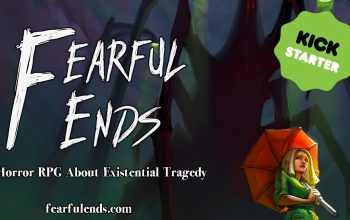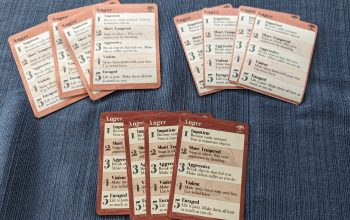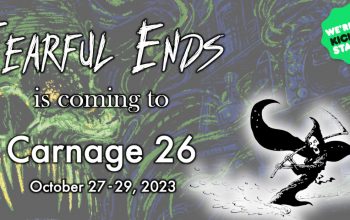
I had planned to post about Bryson Springs this week while traveling, but forgot to take photos of the props before I left. So the props post is going to have to wait until I get home. In the meantime, let’s examine the text of Bryson Springs, and I’ll dig into where it served me well, and where it feels like something’s missing.
Bryson Springs was written by Caleb Stokes and published by Hebanon Games, and is included in a series known as No Security, a collection of systemless horror scenarios set in depression era America. I originally purchased it simply because I was looking for examples of systemless horror scenarios, as I hope to some day publish some of my own work in a similar format. The ones published by Hebanon Games are about the best I could find in terms of formatting alone, and Bryson Springs struck me as a pretty great scenario and worth running in its own right. Then convention season snuck up on me and I realized I didn’t have a new scenario of my own to run, so it got the spot.
While I really enjoy the content of Bryson Springs, I found the organization of the text somewhat spotty. The text begins with two sections titled “Introduction” and “GM Information” which present some very matter of fact description of the root cause of the horrors in Bryson Springs. While the revelation of this will come at the end for the players, if at all, it definitely helps ground the potential GM in the facts which I think is a good thing.
Next we’re presented with a half-page “NPC Relationships” graph, which includes names in boxes and lines between them with one fact connecting each NPC. This is followed by a “List of NPCs”, which again presents the entire cast with a single quick bit of text explaining their role, like “local state police” or “cultist”. These together I think present both too much and not enough information. The graph is a bit overwhelming at first and the list of ten plus NPCs is just too many to keep in your head during the initial read-through. Later, when you’ve become acquainted with all the NPCs and will recognize each by name, the list and graph are simply too lacking in detail to be of real use as a table reference.
After my first run of the game, I spent 30 minutes sitting down with the text and a pad of paper. I wrote down each NPC’s name and half a dozen or so bullets of important information about that NPC. I included information the NPC knows, information they lack, general notes on what their motivations are, etc. This is the table reference I really needed at the first game, and it helped me immensely for the second game. In fact, just the act of writing all that down was enough to get a fair amount of it cemented in my head so I didn’t even need to reference the notes much during play. I thought of including those notes here, but in fact I think my recommendation to the reader is to do this for yourself. I suspect the act of note taking for each NPC is more valuable than the results.
The text next follows with a section called “The Monster”, which details the specific nasty creature the players will face. There’s a convenient little bit of dead white space at the end of this page – perfect for jotting any system specific details you need for the monster in whatever system you intend to run the thing. Next is a section called “Gameplay Information”, which is really about how to help your players create characters for this scenario. This is a clear tell that this game was written more for home campaigns than for convention play. For my own purposes I ended up creating pre-gens, with a little inspiration taken from this section.
Finally is the section labeled “Locations”, which details each particular location the players might visit, who they might encounter there, and some more details on how specific NPCs behave. In fact, it’s buried in the locations that you’ll find the real info on the NPCs, not that part at the front with the graph and bullet list. This makes it somewhat useful at the table, as for example the details on Ye Wang are right there in the section on the Hooverville, which is where the players will likely meet her. Unfortunately when she gets in their car and accompanies them to the police station, and you are trying to remember what she does or doesn’t know about her father’s death, now it’s kind of hard to find. I suspect a stronger separation of “locations and who is there” from “NPCs, what they know, and how they behave” would have been more useful.
Lastly, there’s a section called “End Game”, which hints a bit at a potential climactic encounter with the cultists. If you listen to the actual play recording of the author running this scenario, it’s exactly how his game ends. That said, I find this scenario to be written in a very “old school” style, which is to say it’s heavily location based with little pre-determined “plot”. I put plot in quotes there because obviously there’s tons of plot in the scenario, but it’s all about NPCs and things that happened in the past. The plot of what the players do as they uncover this information is not at all dictated in any way by the text, which frankly I think is super cool.
However, I think this is also where the text falls down. The final encounter hinted at in “End Game” feels to me incredibly unlikely. The cultists themselves seem to live in the Hooverville, and their secret base is hidden in a location that is in no way tied to any other clue in the game. The only clue to connect them at all is their having the same last name as the man who hired the murder victim, and the only source of that clue for the players is Ye Wong. If the author expects them to follow that chain of clues, I don’t see why they’d ever leave the Hooverville and explore any of the other locations.
The way I ran it, Ye is highly motivated to find her father’s killer. I tried to evoke a little Jessica Huang from Fresh Off the Boat when playing her. She’s ostracized by the local community for being foreign, she can’t read English according to the text, but I really didn’t want her to become a princess in need of saving. Rather I had her very cognizant of the fact that the authorities are completely incompetent. Once she discovers the PCs are more competent and in a position to actually do something, she angles hard to help them to investigate, and to be personally involved. Her best lead (in her mind anyway) is that her father and the man who hired him spent a lot of time down at the Ranch, so that’s where she wants to go.
In both my runs, by the time the players got to the Ranch they were starting to lose their minds and losing the ability to track down a murderer. One group wanted to turtle up at the ranch and wait for the backup they called for to arrive, while the other started to fragment, in-fight, and either try to escape or explore the immediate environs (in this case the grove). In both cases I ended up having to create a climax at the ranch or in the adjacent groves, which is pretty natural for the monster, but not so much for the cultists.
Except… why not? The text says the cultists have this hidden base, but why not make them a bit more pro-active? In my first game I had the cultists know that the PCs were looking into their activities and decide to go on the offensive. The players were turtling, so I brought in the attack, with the cultists coordinating with the monster to assault the ranch. In my second game, I had some players in the ranch just trying to not get killed and others exploring the groves, so I positioned the cultists in the groves performing some unholy rite. They managed to actually kill the PCs in the groves, drawing some more in from the ranch with sounds of gun fire, and allowing a couple who were a bit heavier into their insanities escape back to civilization with tales so bizarre they’d surely spend the rest of their lives in an asylum.
All in all both approaches worked very well, but definitely in both cases I felt like I was strongly off script. While nerve wracking at the time, in retrospect it’s something I really enjoyed doing, I just wish the text had prepared me to expect it to go that way. I think the way I’d do it is present a few other alternatives in the End Game section. Off the cuff I’d use my two experiences as examples, but more than offering up those specific scenes to mimic, my goal would be to prepare the reader for the need to improvise an ending based on where-ever the players take the game.
While reading this scenario did help me a little with some basic layout ideas for my own work, I think actually running the game was much more insightful than I expected. I definitely have some strong ideas now on how to format my own work. Also I may just pick another one of these scenarios to run in the future just for the extra data point.
And as critical as I am in the above, I definitely recommend Bryson Springs for anyone looking for a good horror scenario to run. The content is really great, and it’s a ton of fun to play. I’d just seriously recommend writing up your own per-NPC notes before doing so, it’s super helpful.


